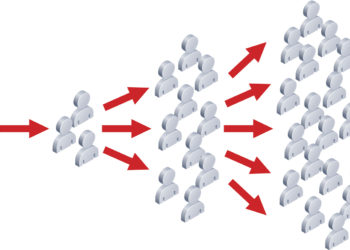DPLA — the Digital Public Library of America — last week laid off six members of its small staff. Over the weekend, DPLA executive director John Bracken, in a talk at the LITA Forum, provided an overview of DPLA’s vision, which appears to include a change in strategic direction. DPLA is a not-for-profit organization with a strong board including library leaders Brian Bannon of Chicago Public, Chris Bourg of MIT, and Denise Stephens of Washington University St. Louis, Oxford University Press’s Niko Pfund, and Wikimedia CEO Katherine Maher, among others. DPLA launched five years ago, with a strategy focused on aggregating and curating special collections and a technical approach that made sense for the web that was celebrated here in the Kitchen. It now appears to be pivoting more towards ebook distribution systems. It is also clearly facing some difficulties right now.

As is often the case with an organization in the process of a substantial redirection, there is too little information for outsiders to offer a conclusive interpretation of events. For example, DPLA’s last tax information on file with GuideStar dates from 2015 (although it is presented in the metadata as dating from 2016), making it difficult to estimate the current state of its finances. While larger companies and universities routinely report in broad terms about the purpose of layoffs, for example as part of a “budget reduction program” or as part of a needed “re-allocation of resources,” such reporting is less common from smaller organizations. The immediate reaction from the library technology community was quite negative, but the long term effects of any immediate loss of goodwill remain to be seen. I am interested in analyzing DPLA’s strategy and strategic shift, but I am not prepared to do that today.
Cautious though I am about reporting on the specifics of the current DPLA news, any event like this causes me to step back and seek the broader story. The scholarly communications sector is probably now more full with start-ups than at any time in its history. Some are commercial initiatives, some are not-for-profit, and like DPLA many are trying to facilitate collaborations and foster communities. For this reason, rather than trying to speculate about DPLA’s future directions and likelihood of success, I would instead like to reflect on some of the lessons I am drawing from the challenges that DPLA and a number of other similarly situated organizations appear to be confronting.
- For a new not-for-profit, grants should be used to establish a business model. For a vision as attractive as the one that DPLA was originally pursuing, it is no surprise that numerous foundations and funding agencies were willing to make substantial resources available. For a new not-for-profit organization, grants and other sources of start-up capital should generally help it to launch a new business with sources of recurring support, not to fund operations on an ongoing basis. An organization that relies almost entirely on grant-based philanthropy can find it is nearly impossible to develop a good sense of the economic demand for its services. And, it seems to be impossible, at least in this sector, to fund operations from grants on an indefinite basis. An organization that cannot develop an ongoing stream of revenues — whether from subscriptions, memberships, service fees, or other sources — will eventually pivot to a new strategy or fail. Funder policy and funding structure has an important role to play.
- Every good idea does not require a new organization. DPLA’s origin story is in resistance to the commercial efforts to digitize books, especially the Google initiative, but it had trouble finding a model for this resistance to book digitization and instead pivoted to aggregate and curate primary source collections. As Joe Esposito has pointed out in these pages, even products themselves, let alone product features, are not themselves businesses. Without ongoing national funding, whether from the federal government or in another form, it was never clear why there should be a US national version of Europeana and Trove. Yet, in library collaborations, as some leaders recognize, we see numerous organizations developed to take on slightly different nuances of the same broad set of challenges that libraries are working to address. Some of these organizations have challenges in defining their strategy in ways that are feasible given the resources they are able to generate, and many have governance challenges resulting from membership organizations with operational aspirations. In the next year, I expect to see a number of pivots, mergers, and other changes among library collaboratives.
- Start-ups involve labor precarity. All new organizations, especially those without an established revenue base, are risks. In the commercial sector, there is often a high upside for early employees who take a risk on the venture, if it is successful. In the not-for-profit sector, it is important for startup leaders and funders to recognize that they are asking potential employees to bear risk without providing substantial financial upside in the event of success; just as much as it is important for employees to recognize and, to the extent possible, negotiate the parameters of their employment, including termination scenarios. Layoffs are always personally difficult even when handled in the most compassionate ways possible, with transparent communications and generous severance, each of which is not always easy to provide. At the same time, it is impossible to have innovation without risk.
- Primary source materials are valuable even if sustaining their ready digital availability is not simple. Efforts to provide ready online access to the library community’s digitized primary source materials has been a long-standing challenge. Individual libraries’ digitization efforts have typically resulted in relatively siloed online access. Approaches to making such materials available through curated and commercial models, such as those under the ProQuest umbrella, have served to increase access substantially. DPLA saw an opportunity to make a radical improvement in the availability of these library riches, through the community of hubs that it has helped to foster and its own work to aggregate and curate across repositories for educational and other purposes. Its efforts to build a membership-based revenue stream do not appear to have been sufficient to allow this work to be sustained at recent levels over time. Perhaps DPLA can continue some aspects of its work at a lower level or with greater efficiencies. Fortunately, the underlying digitized primary source materials are not at any greater risk, since they are held by the partner repositories. Looking ahead, given the value of primary sources to research, teaching, and learning, I will not be surprised to see others attempt to take on elements of DPLA’s work, perhaps under other kinds of open models.
- The library ebook marketplace remains unsettled. While DPLA’s origin story was in resistance to Google Books, its next chapter appears to rest to a large degree on its ability to establish a marketplace for ebook distribution to public libraries. This is a major pivot in audience and mission, in a space where there are already a number of established organizations. It is also working in partnership with LYRASIS, New York Public Library, and others. Will DPLA be able to succeed in this role? Certainly, if it can succeed in bringing a more print-like experience to the work of acquiring and circulating ebooks, it will be a real benefit to libraries and readers alike.
Others will draw additional, or perhaps different, lessons from DPLA’s change in strategic direction, and I am eager to hear them as well. I believe it is vital that we not allow our discomfort with the challenges faced by organizations in our sector to limit open discussion of lessons we can learn.
I am grateful to Danielle Cooper, Joseph Esposito, Lisa Janicke Hinchliffe, Kimberly Lutz, Deanna Marcum, Tim McGeary, Susan Parker, Oya Rieger, and Christine Wolff-Eisenberg, for reading a draft of this piece. The lessons it proposes were strengthened by their input but do not necessarily reflect their views.
Discussion
16 Thoughts on "Learning Lessons from DPLA"
Excellent post Roger, where do you see the ‘diversification of revenue streams’ in this model/sector above, outside the building business models point 1 you note, and the not having all your eggs in the ‘grants basket’. A society publisher may have more balanced revenue/income from meetings; membership, and publications (subscription or APC), in a similar way SSP has membership and meetings/events that generate funds, then there’s the Knowledge Unlatched model where the community all support, for the broader good. I’m interested to hear a little more on this sector and DPLA.
Adrian, I won’t speak to DPLA’s specific models or plans, but generally speaking I think we see rather different approaches to funding initiatives for what is, ultimately, metadata aggregation and curation. In the commercial sector, Web of Science, Scopus, ProQuest’s Summon and Primo, and Ebsco Discovery Service, among many others, have built what appear to be successful revenue models. Elsevier and Clarivate have each been building an array of new services on top of the metadata aggregations, for example through Pure and SciVal in the Elsevier suite. Of course, a commitment to open (such as that which DPLA has maintained) will pull in other directions, and Dimensions may offer an example of a reasonable freemium/hybrid, again with associated services. The special collections focus of DPLA probably pulled against some of the revenue opportunities, but those are the kinds of examples I suppose I would point towards. I would love to hear your thoughts as well.
Roger, thanks for your early and always insightful thinking, in this case on the current state and future prospects for DPLA. Just a few quick comments on your observations. You are absolutely correct that the funding from federal and foundation sources for the launch and development of DPLA included expectations that a viable business model would be an outcome of these investments. I recall attending the series of meetings convened by IMLS where the decision to transition from many smaller grants to fewer and larger grants in support of infrastructure initiatives like DPLA was worked out, and with this expectation of transitioning at some point to a self sustaining enterprise. We do like to spawn new organizations in the library community. At the meeting where DPLA (then DLA) was conceived and advanced, there was much discussion whether existing organizations, in particular the Library of Congress, would be able and willing to provide the leadership and support. Recognizing that not possible at that time, the idea of a new 501(c)3 was debated. I do wonder if the aggregation and curating of special collections strategy can be embraced by existing organizations that work in the national/global metadata space. The work of DPLA has focused on digitized works, and has not broached the complex challenges of capturing, organizing and archiving the vast array of born digital content increasingly important to education and research. Its interactive, multimedia, and dynamic characteristics demand a national systemic approach. And the DPLA focus on ebook accessibility in public libraries is a critical issue crying out for creative solutions. From the library perspective, the pricing model, the contract terms, the commitment to long term availability and usability, accessibility for the print disabled, privacy, and just the ability to license materials from publishers need to be on the table. There are a number of organizations working on these areas. What can DPLA bring to these discussions? And how will DPLA sustain itself financially with this pivot in strategy? I must add a final point. There has been massive investment at the local, state and regional level in the development, implementation and maintenance of content and service hubs for DPLA content. I have been involved in the NY state service hub at Metro, and we are deeply concerned. Were they consulted and involved in the decisions on the changes in direction? Roger, thanks for advancing the conversation.
I am in NO way defending the actions of the DPLA layoffs, but working on business models is a lot easier said than done. I can tell you that DPLA spent a number of years and a lot of energy thinking about business models, but we (the small staff) also had other grants to manage (up to 7 at once) and constant performance measures to meet. A membership model was rolled out for
the hubs network as part of the sustainability plan, and while it wasn’t wildly popular, eventually, most hubs paid membership. But our community has membership fatigue – they are tired of paying membership fees – and $10K from about 30 hubs only amounts to a fraction of the overall DPLA budget. Also, there are the individual desires of funders and the directions they insist the organization take in order to receive funding. Funding doesn’t come without strings. So I guess I write this comment to ask how do we sustain not-for-profit organizations in the cultural heritage space? Most organizations in this space are currently struggling or have either had to reinvent themselves or depend on international membership for survival. One notable exception is ArchivesSpace, who already had a product people used and continue to want, who found an organizational home at Lyrasis. The Lyrasis model seems to be to provide as many different services to as many groups as possible to survive. There’s not room in the cultural heritage space for many more of those organizations. I, like you, feel like we are going to see many more mergers and organizations fold or change significantly. (If we recall, Lyrasis is a merger of former OCLC regional networks after their funding was slashed.) I think we have to ask ourselves why this is happening and if we, as a community, care enough to change this or just let it be and consider it the natural order of things and/or survival of the fittest.
Emily, thanks for these comments. Lots to keep thinking about here. I really appreciate your work on DPLA and your contributions to the discussion, in recent days and now here.
Without knowing anything about the specifics of DPLA’s grants, there is a real difference between project-level grant-making and providing the kind of working capital, with fewer or no strings attached, that is ultimately needed to launch a new organization and a new business. I so sympathize with the challenges of managing all those grants in a start-up mode.
And as you say, these are just some of the challenges of establishing a business model for any new organization, especially I would emphasize one that is ultimately working for the public good. Like you, I am hearing from more and more libraries that they are feeling tapped out from these membership models.
I do think the model of Lyrasis as a membership-driven host organization, ideally providing core services on a shared basis that drives efficiencies, can be valuable for the community. Where that may face challenges is from other providers that are building deeper integrations across individual services in an effort to drive additional value. But just as Digital Science evolved from investor/host to to integrator, perhaps Lyrasis will drive in such a direction as well.
Ahh so good old strategic competitor and market analysis … a lot of similar type offerings playing in the same sand box … is the potential reason for the/a pivot … and as Joe E has said a few times, pivoting is not always a bad thing, and can be described as ‘agile’ in the start-up world
Roger, thanks for identifying the different threads suggested by the DPLA announcement of the past weekend. As to funding models, most university libraries are and are a part of non-profit organizations. This drives my thoughts about the difficulty libraries have in participating in membership or other kinds of funding models for multiple start-ups like DPLA. We must pick and choose among them, even when we like them all. Also, there can be significant peer pressure to “chip in” to help fund worthy and sometimes quite timely causes. Libraries themselves have funding issues, and are not able to promise that next year they can renew funding they contributed this year. It would be helpful to consider how many great ideas can be surfaced and nurtured into sustainable long-term collaborations, perhaps under fewer umbrella organizations.
I think the best way to finance these initiatives (which are wonderful, in my opinion) is through subscriptions. That would require that the initiative create something that is responsive to actual demand. Libraries would not be asked to be members. The marketplace will help to evolve the service offering. There is nothing incompatible with a not-for-profit organization and a subscription model. Note that this kind of service could NOT be done by a for-profit company, as it would be working with many public goods.
Joe, without getting into an examination of the DPLA business itself, I agree with you that subscription and freemium/hybrid models are worth considering. One challenge has tended to be how community leaders balance this against what is seen to be an “open” imperative. It is not by any means impossible to do so.
I agree that subscriptions is one viable option to consider to finance these initiatives, but I disagree that this could not be done by a for-profit company. RedHat, as one example, did just this. They, as an initiative, created a flavor of Linux responsive to actual demand and then created a subscription model to, again, be responsive actual demand. A free version always remained available and one they continued to contribute to. The enterprise model had a variety of levels, including focused on educational and non-profit organizations. And they retained (and I would argue even enhanced) their reputation for supporting and investing in open source.
I agree with you that DPLA could do the same thing. I believe Lyrasis is already doing something similar. And I would argue that a for-profit startup could try to do something similar, especially if it made a commitment to re-invest its profits at an appropriate level. I would agree that an establish for-profit, like the big ones in this content space, would have a steep hill of credibility to climb.
Joe, perhaps you can elaborate on the difference between a subscription model and the membership model DPLA had adopted? If it is a distinction with a difference, it would be good to learn what they would then be. (Per Emily’s note above, institutions also suffer subscription fatigue as well as membership fatigue.)
Sure, I can elaborate. My understanding of the membership model is that it is like NPR. You become a member, but you don’t have to be a member to listen to it. You may get some added benefits for becoming a member, but the core programming is available to everyone, member or not. This places you squarely in the free rider problem, where some people will not become members because they don’t have to. Under a subscription model there is no free rider problem because you can’t (metaphorically) hear the music unless you pay up. The virtues of the subscription model are many, not the least of which is that it creates a market mechanism for where a society should allocate resources. Can’t get enough subscribers to pay for your service? Well, then, maybe this is a service that is not nearly as great as the people who created it believed. I hasten to add that not everything should be sustained by a subscription model, but something like DPLA could have been meaningfully organized in this way. There are, of course, many varieties of subscriptions.
What a welcome surprise it would be if the library community’s consultant class (or perhaps the ALA president) cared to make an ethical case for the type of national funding you suggest would be crucial to this project. It is very disappointing to see how deeply the author and commentators have internalized the logic of markets and products, seemingly at the expense of the ability to plainly state what is just and appropriate for preservation and access of our cultural patrimony.
I so hope we can elevate leaders who care to create the possibility of the Library of Congress (or a new People’s Library) supporting such initiatives, and forcefully state the case for such in public.
I’ve written about some of the structural reasons why Europe approaches scholarly communications differently than does the United States (https://scholarlykitchen.sspnet.org/2018/06/18/will-european-contagion-spread/). I’ve also written about some of the challenges faced in the United States as we seek to build up from regional to national efforts for print preservation, only to find that we cannot sustain them (https://sr.ithaka.org/publications/taking-stock-sharing-responsibility-for-print-preservation/). I would love for there to be reliable national funding in the United States for preservation. This is an issue close to my heart, and it informs my civic engagement. It is also painfully absent. I do not see the value in performatively wishing it were otherwise every time I write a piece trying to help leaders develop organizations and strategies that can operate and persist in the actual funding environment that has existed in the United States for decades.
Roger, totally agree with you about the need to host these orgs and provide common services – everyone doing their own payroll, etc. is not efficient. I just see Lyrasis as an org providing a lot of different services these days – subscription services to journals, technology hosting, organizational home, ebook ventures, etc. My only point on that was that there isn’t much room for too many orgs to expand like that – likely collapsing or merging is more likely.
Thanks, as always, for your thoughtful insights. Sustainability is something we talk a lot about, and to me the one thing that remains clear is that it is hard. A lot harder to do than it is to talk about.
DPLA’s Board (without its executive director) released a statement today, recognizing that communications were muddled and explaining that “the manner in which we have been operating is not sustainable in the long term. In recent months, a hard look at DPLA’s finances highlighted that to continue serving our mission, we needed to reduce our cost base.”
https://www.infodocket.com/wp-content/uploads/2018/11/DPLA-Community-Letter-Response.pdf


